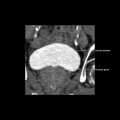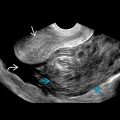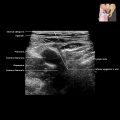KEY FACTS
Terminology
- •
Inflammation of intra-/extrahepatic bile duct walls due to ductal obstruction and infection
Imaging
- •
Dilatation of intra- and extrahepatic bile ducts
- ○
In cases of early cholangitis or intermittent common bile duct obstruction, bile ducts may not be dilated
- ○
- •
Circumferential thickening of bile duct wall
- •
Presence of obstructing choledocholithiasis or obstructing tumor
- •
Periportal hypo-/hyperechogenicity adjacent to dilated intrahepatic ducts
- •
Presence of purulent bile/sludge
- •
Multiple small hepatic cholangitic abscesses
Top Differential Diagnoses
- •
Cholangiocarcinoma
- •
Pancreatic ductal carcinoma
- •
Primary sclerosing cholangitis
- •
Recurrent pyogenic cholangitis
- •
Other forms of secondary cholangitis
Pathology
- •
Pathogenesis
- ○
Stone/stricture → obstruction → bile stasis → increased biliary pressure → infection
- ○
- •
Risk factors
- ○
Choledocholithiasis: Most common
- ○
Biliary stricture, biliary stent, choledochal surgery, recent biliary manipulation, and sphincter of Oddi dysfunction
- ○
Clinical Issues
- •
Charcot triad: Right upper quadrant pain, fever, jaundice
- •
Complications: Cholangitic liver abscesses and septicemia, portal vein thrombosis
- •
Treatment: Antibiotics and biliary decompression
Diagnostic Checklist
- •
Correlate with clinical and laboratory data to achieve accurate imaging interpretation
Scanning Tips
- •
Look for distal obstructing lesion as most cases of cholangitis occur in partially obstructed biliary system
 with only minimal luminal
with only minimal luminal  distension.
distension.










